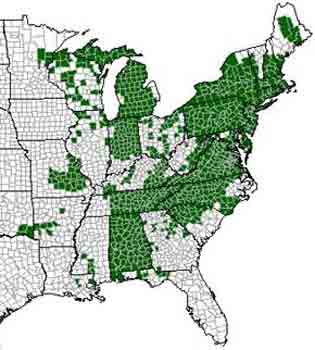 |
 |
Distribution of the Four-toed Salamander (from the AR MI Atlas)
|
An adult Four-toed Salamander.
|
Description: A small (>4”) woodland salamander easily identified by three characteristics: four toes on each hindfoot (unique among Ohio’s terrestrial salamanders), distinct constriction band around base of tail, and ivory white belly with irregular black speckling.
|
|
Distribution in Ohio: Uncommon, widely scattered populations.
|
|
|
Status in Ohio: The Ohio Division of Wildlife lists the Four-toed Salamander as a SPECIES OF SPECIAL CONCERN.
|
|
|
Habitat: Mainly a species of mature swamp forests, undisturbed vernal ponds, and surrounding forests. During the breeding season often found around margins of ponds. Outside of breeding season the Four-toed Salamander lives in underground burrows or under logs and other debris on the moist forest floor.
|
|
|
Life history: Courtship, mating, and egg-laying are all terrestrial activities, but larvae of the Four-toed Salamander are aquatic. Breeding may occur in both autumn and spring. Females lay eggs in areas where larvae will be able to enter the water upon hatching -- usually under moss on tree trunks or logs overhanging water, in island hummocks within the pool, or under logs along the pond’s margin. The eggs hatch in 5-8 weeks and the aquatic larvae complete metamorphosis in six weeks. Animals become sexually mature after 2 years.
|
|
|
Conservation: Four-toed Salamanders are usually associated with undisturbed forested wetlands with heavy moss growth. Threats to this species include wetland filling and draining, introduction of fish to breeding ponds, pollutants, such as insecticides and herbicides, and loss of adult habitat.
|
|
|
|

